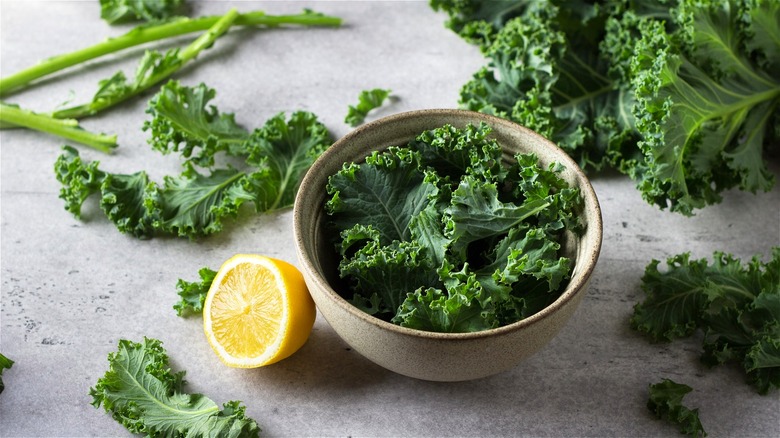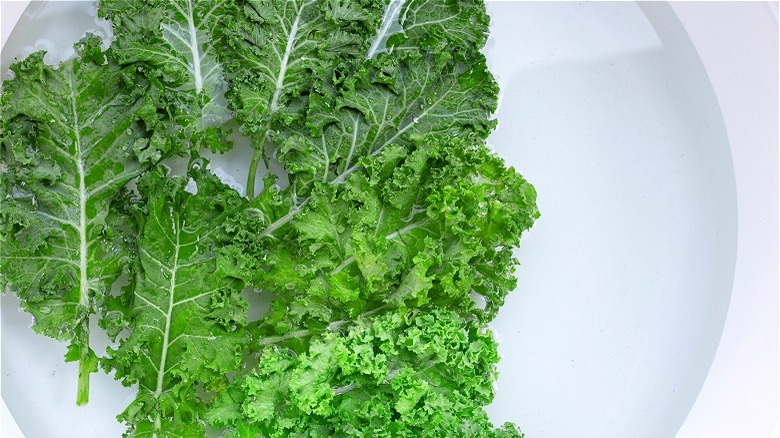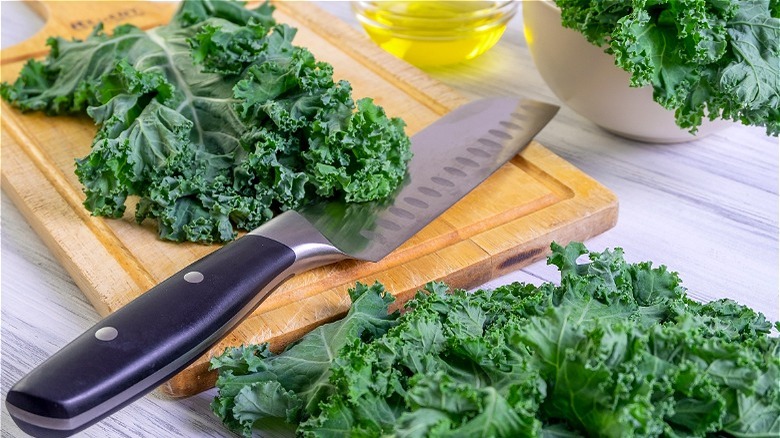The Trick That Will Help You Make The Best Kale Salad Yet
If you've been making a concerted effort to consume more vegetables, there's a solid chance you've added dark leafy kale to your latest pot of soup — or even tried incorporating a new snack into your daily repertoire by following an easy kale chips recipe. Kale wasn't always an everyday choice, however. MindBodyGreen uncovered the PR scheme behind kale's popularity in the early 2000s, thanks to Oberon Sinclair and her divisive strategy behind creating the American Kale Association to encourage more people to eat the hearty vegetable.
Beyond kale's stint of trend-setting consumption, according to Produce Market Guide, people still spent $225 million on kale in 2020 due to its year-round availability and adaptable nature. You can find ways to incorporate the hearty green into smoothies, kale pesto, and commonly, as a healthy base for your next meal salad.
Harvard Health Publishing reminds salad lovers that in order to meet the USDA's recommendations for vegetable intake, consumers need to eat twice the suggested amount when choosing leafy greens. Mayo Clinic Health System claims kale is a cold weather crop, and can hold its stiff texture while cooking, but in a salad that may do more harm than good. Chewing through sturdy leaves doesn't seem like the most appetizing option. But there is one trick that can slightly alter kale's texture, transforming your usual stiff plate of greens into one award-winning salad.
Soaked kale makes epic salads
Before you attempt to make the ultimate kale salad, you should know how to elevate the hearty green before piling on other fresh components. According to Mayo Clinic Health System, in order to remove any bitterness found in kale, you should always remove the inner stalk of each leaf, as it tends to be the hardest part. Another common method used to soften kale's texture is to massage the leaves. Beyond removing the middle ribs, Masterclass advises using olive oil, lemon juice, and salt, working the kale between your hands for roughly five minutes until the greens take on a noticeably softer texture.
However, the soaking method is more hands-off and guarantees similar results. Soaking not only gives kale that desired tenderness, but simultaneously cleans the leaves during water immersion. America's Test Kitchen suggests adding chopped kale to a bowl with water measuring 110-115 degrees Fahrenheit. Let the kale soak in hot water for roughly 10 minutes and then remove the soaked goodness from the water directly (as opposed to pouring kale into a strainer). This way, you ward off any potential dirt and sediment collected during soaking. Then all you have to do is dry the leaves before enjoying under a mountain of fresh apples, goat cheese, or whatever you love most.
Soaking kale not only makes the leaves softer, but water increases the leaves' palatability — due to the bitter-tasting compounds noted in most cruciferous vegetables.
The science behind kale's bitter flavor
According to Everyday Health, kale is a member of the cruciferous vegetable family, which also contains cabbage, Brussels sprouts, and broccoli. Apart from the leafy green's slew of health benefits (which include ample doses of vitamins C, K, and A), kale and its cruciferous cousins all contain glucosinolates. These produce a somewhat bitter flavor when chopped due to the phytochemical's sulfur content (per Harvard Health Publishing).
When broken down, all cruciferous vegetables release special isothiocyanates. These have been proven by one 2022 study to have immeasurable health benefits, including bacteria-fighting agents, an abundance of antioxidants, and properties that support neurofunction. While these special compounds can add to kale's bitter flavor, there are ways to curb that sharp taste without losing any notable health benefits.
One 2020 study in the journal "Food Science & Nutrition" found that certain cooking methods can severely alter the isothiocyanate content. While heavily boiling and stewing can remove these unique compounds, you can consume them in their highest nutritional form by blanching (which mirrors the soaking method detailed above). Elizabeth Jeffrey, Ph.D. suggests beyond blanching and steaming, stir-frying cruciferous vegetables also retains most of their nutritional components (per Karen Collins). So if you want to avoid the bitter taste that comes with all kale varieties, try the soaking method for your next salad recipe and judge the results yourself.


